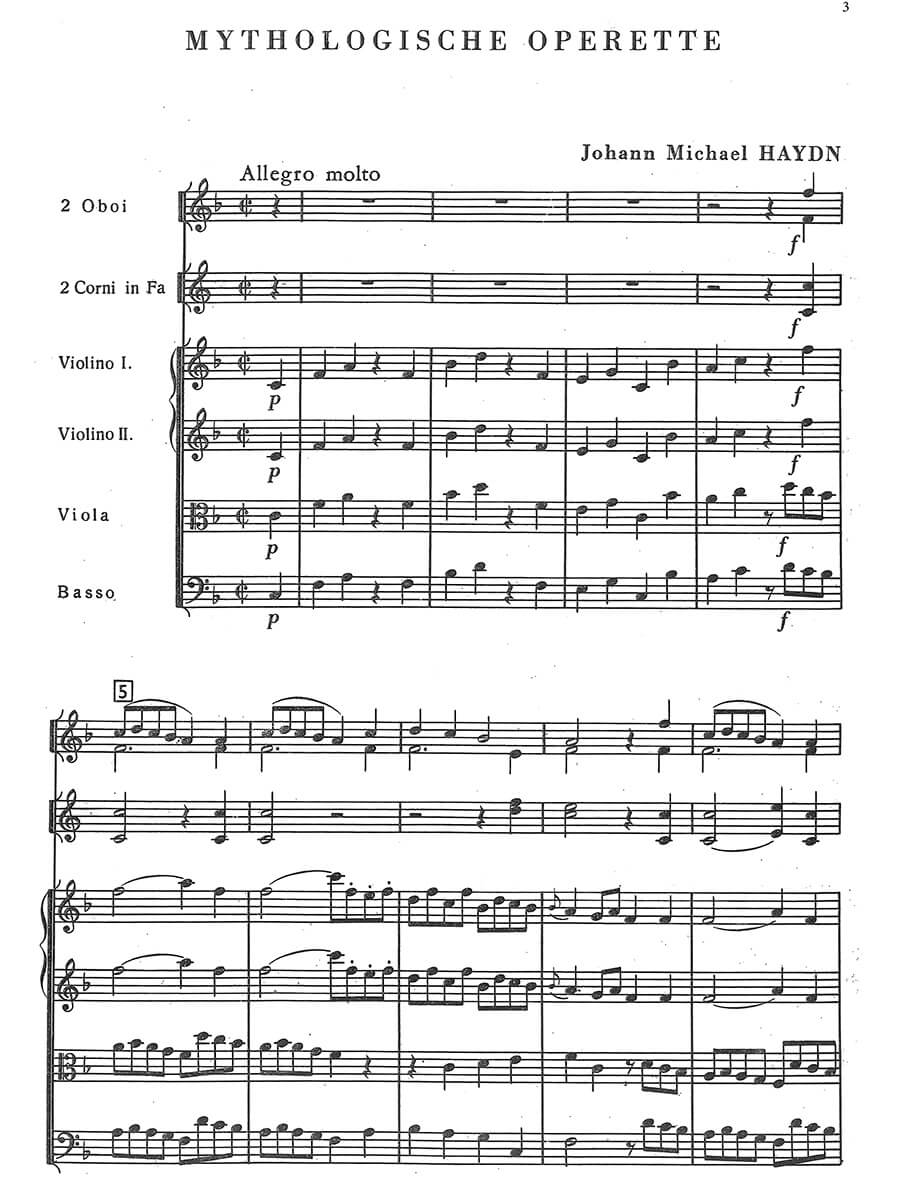Mythologische Operette (Sinfonia, Menuet, and Finale)
Haydn, Michael
19,00 €
Preface
Michael Haydn – Mythologische Operette
Sinfonia, Menuet, and Finale
(b. Rohrau / Lower Austria, 14. September 1737 – d. Salzburg, 10. August 1806)
Preface
Johann Michael Haydn was a prolific composer, primarily remembered for his sacred music. Born in 1737 in Rohrau, Austria, he began his musical career as a choirboy at St. Stephen’s Cathedral in Vienna. By 1763, he became Konzertmeister to the Archbishop of Salzburg, where he would live for the remainder of his life. Although he did not maintain the same level of fame as his older brother, Joseph Haydn, he was a master of the stile antico, producing nearly 400 sacred works and more than three dozen masses. His vast body of work and his reputation as an excellent composer eventually earned Empress Maria Theresa’s favor. Although the majority of his works were sacred, Michael Haydn also composed secular music, including several Italian cantatas, German oratorios, and Singspiele. His Schuldrama, Mythologische Operette, for example, remained in obscurity until recently due in part to its ambiguous title. Mythologische Operette proves to be an important work because it gives us insight into a now obscure genre, the Schuldrama, as well as into Michael Haydn’s compositional style in the secular realm.Schuldrama were academic dramas, usually with a Protestant allegorical theme, created for performance in schools and universities. Court musicians generally provided their music. From 1767 to 1771, Michael Haydn was composing Schuldrama at the Benediktineruniversität in Salzburg. These performances were popular and accessible to most citizens, both financially and aesthetically. In Mythologische Operette, the libretto was taken from a popular poem by P.F. Reichsiegel, entitled, “Die Wahrheit der Natur, in den drey irdischen Grazien, nämlich in der Dichtkunst, Musik und Malerey.” The poem is a Scherz-und Lehrgedicht, a comic poem that teaches a moral lesson. The story follows the Mentor, an embodiment of Reason, and the three earthly Graces, the daughters of Nature, as they seek true art. The Schuldrama would have been known by the libretto’s title; however, Michael Haydn titled his score for the poem Mythologische Operette. Despite the different titles, because the names of the characters from the original libretto appear in the musical manuscript and because Michael Haydn completed the composition on July 7, 1769, just days before the performance of “Die Wahrheit der Natur,” scholars are sure that the music for Mythologische Operette was performed with Reichsiegel’s libretto.
This three-movement version of Mythologische Operette excludes the vocal movements of the original Schuldrama and reduces the six orchestral movements to the three most notable: the opening Sinfonia, a Menuet, and the Finale. All movements are in F major, creating a cohesive concert piece.
In true eighteenth-century style, the single movement Sinfonia is written in sonata form. The opening theme is a quiet, bouncy unison which leads immediately into a freer, rhythmically driven forte melody. The two alternate frequently, contrasting the homophony of the main theme with the simple melody. The secondary theme mimics the first, in the minor mode, creating a stormy atmosphere. This darker mood eventually gives way to a soft and peaceful close that leads into the second movement. The second of two minuet and trios that appear in the original Schuldrama, the Menuet in this edition is a playful movement with an outstanding trio. With triplet rhythms characteristic of the galant style, the strings lead the lively tune through rapid harmonic development. Despite the piano dynamic, the trio builds through rising triplets and a soaring first violin line, coming to a quiet end before the piece returns to the forte, homophonic minuet. The Finale, also in sonata form, is the longest movement by far, and features a stately opening that quickly gives way to a fantastic violin line. Tension builds through a singing violin melody that changes moods unexpectedly, maintaining suspense. The movement ends with a long coda that, like the beginning of the piece, seems to build a sense of tension through constantly rising melodic gestures and piercing violin notes. The suspension is relieved with a gentle, piano close, surprising the listener to the very last measure.
Above all, Mythologische Operette provides a glimpse into Michael Haydn’s secular style and into the Schuldrama as a genre. Despite the old-fashioned reputation his sacred works have earned, this piece evinces an engagement with the simple, yet dynamic and playful characteristics of a more secular galant aesthetic.
The autograph score that this edition is based on is preserved at the Music Department of the National Széchényi Library, Budapest, Hungary, marked “Ms. Mus. II. 112.”
Kinley Johnson, 2018
For performance material please contact Zenemuediado Vallalat, Budapest.Reprint of a copy from the Musikbibliothek der Münchner Stadtbibliothek, Munich
Score Data
| Edition | Repertoire Explorer |
|---|---|
| Genre | Orchestra |
| Performance Materials | available |
| Size | 210 x 297 mm |
| Printing | Reprint |
| Pages | 52 |
